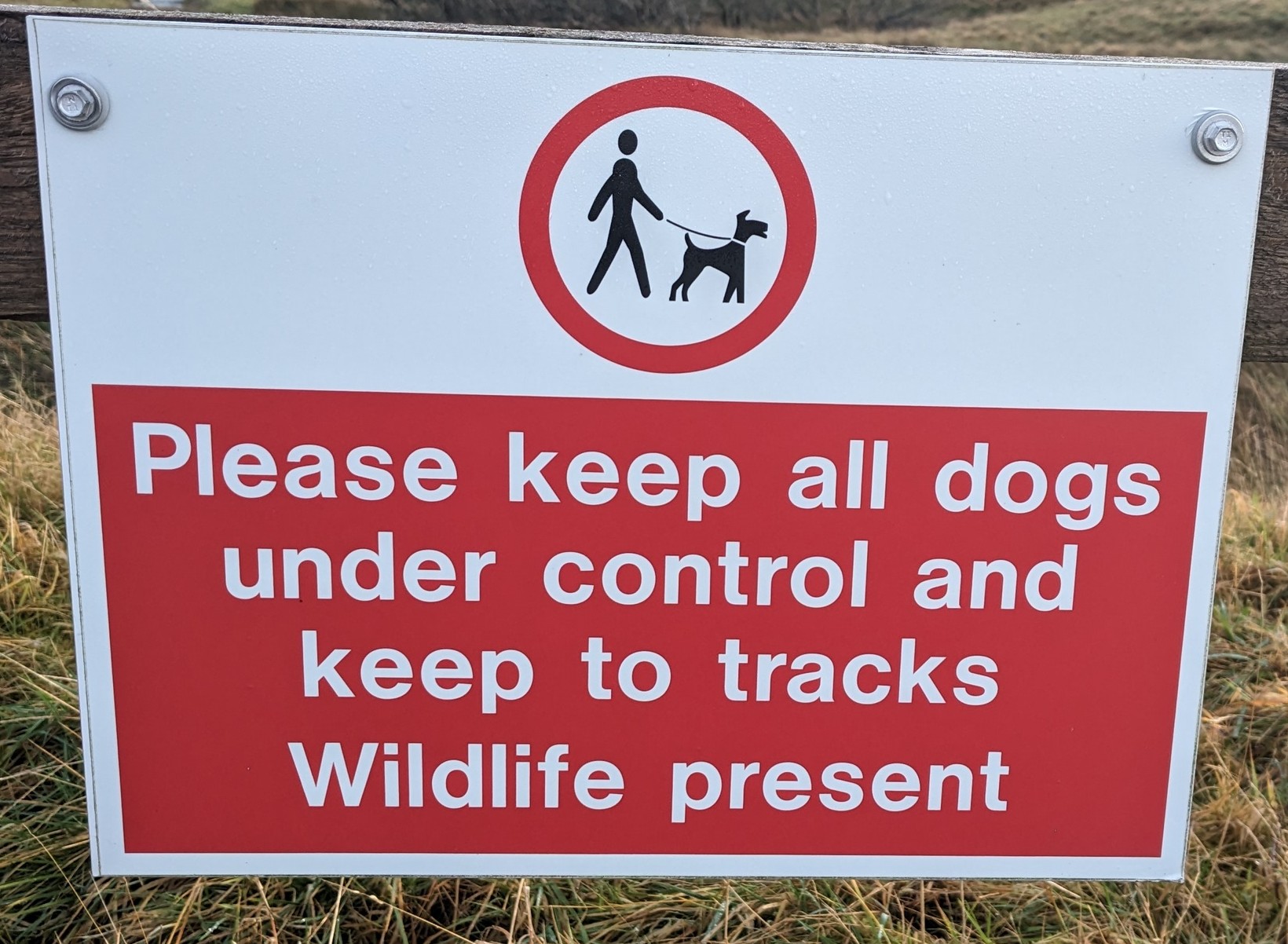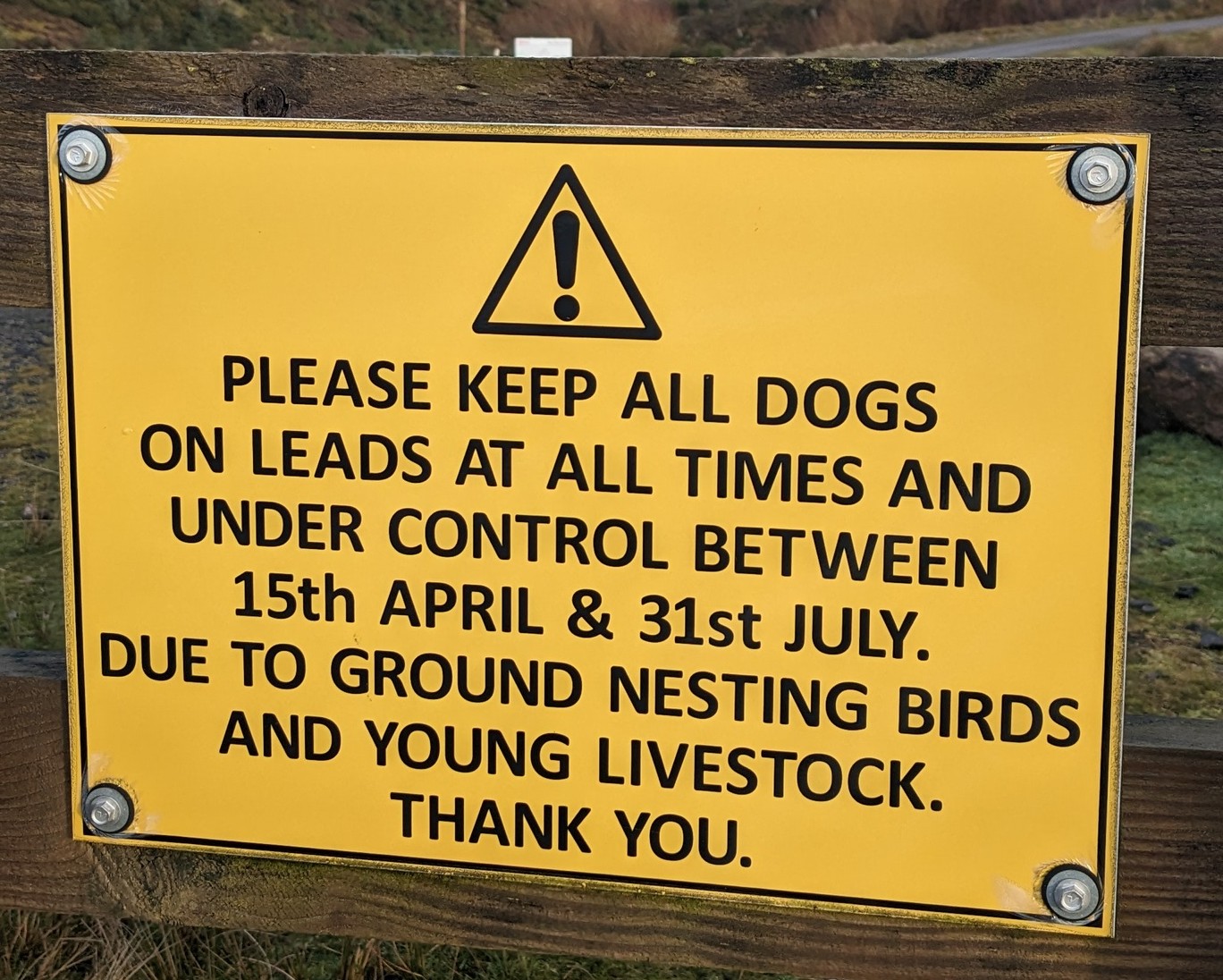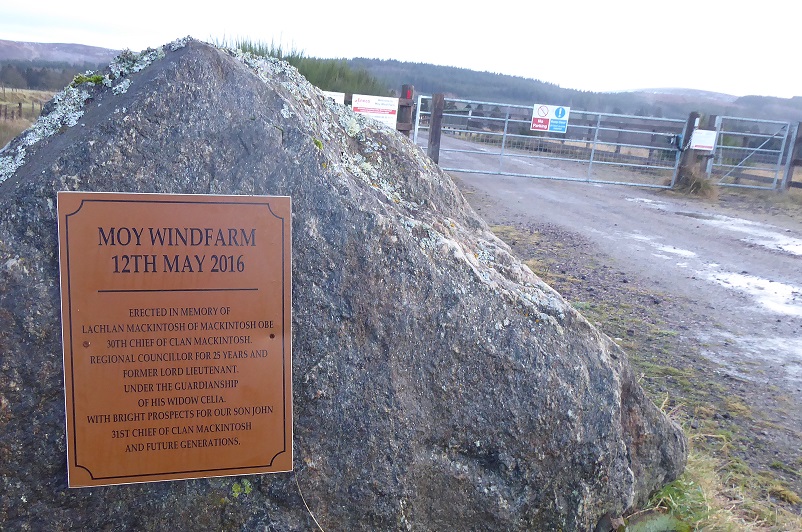
Wildlife, however much depleted, is present everywhere. Consequently if wildlife was a reason to keep to tracks there would be no right to roam anywhere. And in my case I could not have attained my objective on Hogmanay, the trackless summit of Carn nan Tri-Tighearnan a few miles north of the Cairngorms National Park. The sign is clearly unlawful and I have reported it to the Highland Council Access Team.

Another sign made me smile and not just because of the grammar. The implication is it’s acceptable for dogs to be out of control for 8 months of the year so long as they are on a lead! One wonders too if “all dogs” includes the working dogs of the gamekeepers and shepherds?
Although unattributed, it seems likely both signs were put up by the Moy Estates since there was another credited sign from the windfarm operator next to them:

Generally this sign is far more helpful: it refers to the Scottish Outdoor Access Code; says nothing about keeping to tracks; and advises of dangers of being close to the turbines in certain weather conditions. Since some of the wind turbine blades extend out over tracks it appears Eneco is saying that keeping to the track when there is a risk of falling ice is unwise to say the least.

The messages to the public given by the Welcome to the Moor sign, versions of which have been erected by grouse moor owners across Scotland, are slightly different to those on the estate signs: “it is recommended to keep to paths and tracks where possible“ and “please keep your dog on a lead or under close control”. The message about dogs is actually sensible and compliant with the Scottish Outdoor Access Code (SOAC) but how would anyone know which of various messages to observe?
The subtext on all the signs when it comes to paths and tracks is, however, basically the same. People are only welcome so long as they don’t use Scotland’s access rights to roam the countryside and explore away from paths and tracks.
So why are such messages still being promulgated almost twenty one years after the Land Reform Act was passed?
Reasons why people being asked/told to keep to paths and tracks

An underlying reason, I believe, is many landowners are still very possessive about the land they own. They regard the land as theirs and not a shared resource. Another sign at the entrance to the windfarm gave an indication of the cultural baggage surrounding some private landowners views: the bright prospects are for “our son John” not the people of Scotland. Added to that is the enormous wealth of many large landowners, which tends to result in access being seen as being about “them and us”. As a consequence many landowners’ default position is to view those exercising the right to roam with distrust. These attitudes about property extend to some public authorities, like the Loch Lomond and Trossachs National Park, and some NGOs, like the RSPB (though in the RSPB’s case that has been gradually changing).
In most cases, however, landowners have managed to live with the public and some do genuinely welcome visitors. Among the large private landowners, stalking estates are generally now more relaxed about the idea of people exercising the right to roam by walking off path. This change has been made possible by knowledgeable and skillful stalkers who have learned where and how to shoot deer around people enjoying other forms of outdoor recreation. It has also been helped by the lead given by Wildland Ltd and some of the conservation NGOs who have managed to shoot large numbers of deer without offering any recommendations to the public about restricting their right to roam.
On grouse moors, however, the situation is now very different and is exemplified by the Welcome to the Moor signs that are to be found across Scotland. The reason that grouse moor owners don’t want people to exercise the right to roam off paths and tracks is NOT because of the actual grouse shoots which only take place on a few days a year. These are easily avoidable and if anyone did try to walk through a grouse shoot they could potentially face being charged with aggravated trespass, which makes it an offence to deliberately disrupt a lawful activity on private land.
No, the main reason is that grouse moor owners are trying to get people to keep to the path is they want as few people as possible to see what is going on on their land. That is exemplified by the Moy Estate which has a long history of raptor persecution and where in March (see here) a gamekeeper was convicted for killing a sparrowhawk.

In 2022 NatureScot suspended the General License on the Moy Estate for three years. The General License allows landowners to kill certain species of wild bird without permission but does not cover mammals. It would appear that the Moy Estate now realise they are being watched because on my walk I saw a sparrow hawk, a buzzard and two red kites (it was the poisoning of a red kite back in 2020 that led to NatureScot suspending the General License two years later).
 However, the legal persecution of mammals and muirburn continues unabated (see here) and it would appear the primary purpose of moorland management on the Moy Estate remains the maximisation of the red grouse population for sporting purposes. So long as that is the case, the forces driving the killing of the many species of raptor that prey on red grouse and their chicks will remain. The Scottish Parliament help change that by extending licensing provisions to cover mammals under the forthcoming Wildlife Management and Muirburn Bill.
However, the legal persecution of mammals and muirburn continues unabated (see here) and it would appear the primary purpose of moorland management on the Moy Estate remains the maximisation of the red grouse population for sporting purposes. So long as that is the case, the forces driving the killing of the many species of raptor that prey on red grouse and their chicks will remain. The Scottish Parliament help change that by extending licensing provisions to cover mammals under the forthcoming Wildlife Management and Muirburn Bill.
Whatever changes are made to the law on grouse moors this year, the best deterrent to wildlife persecution on the ground will remain people exercising their right to roam. Unfortunately, instead of facilitating and encouraging people to exercise their right to roam over grouse moors, Scotland’s access authorities have been slow to act. Raptor Persecution Scotland reported in June (see link above) that the first sign featured here, telling people to keep to tracks, had been reported to Highland Council. Six months later it is still there.
The more general problem is the “Welcome to the Moor” signs. If you followed their advice access to somewhere around 10-20% of Scotland – no-one seems to know how much of Scotland exactly is managed as grouse moor – would disappear overnight. I don’t know of a single case where an access authority has required one to be removed.
The failure of the Cairngorms National Park Authority to act, even though I understand its logo has been used on many of the signs in the National Park without its permission, is particularly disappointing. It could have been showing a lead to the whole of Scotland but instead effectively been supporting the sporting interests that continue to kill large quantities of wildlife contrary to its statutory conservation duty.
The disconnect between the CNPA’s approach to beavers (the subject of my next post) and the protection of other mammals such as foxes, stoats and weasels is a gap it needs to address. Instead of seeing visitors as a problem, whose enjoyment of the National Park should be confined to paths, it needs to see them as an asset which can help it change the way sporting estates are managed.
Happy New Year!

Well said, Nick, however I suspect your comments on CNPA failures on this issue will, as usual, go unanswered by CNPA.
I meant to add, that Highland Council will also do their usual best to ignore your comments on this issue.
I have been in touch with Highland Council Access Team who had missed the original complaint about the sign and apologised for this. They are now investigating the signs and I will cover the outcome of that in due course. In my experience the Highland Council Access Team are very good at challenging and getting unlawful signs removed but I have not complained to them about a Welcome to the Moor Sign before.